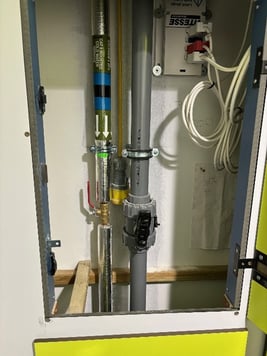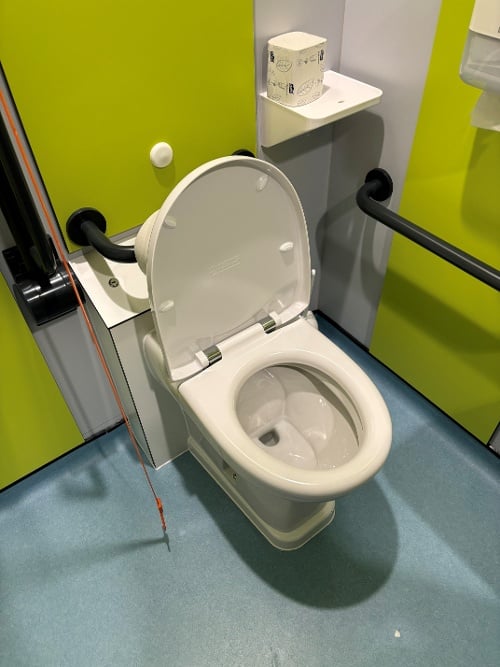Many of us have had the pleasure of squeezing into an aeroplane toilet, and in most cases had the novel experience of using the vacuum flushing toilet. Some of us in the water industry may have even switched out of holiday mode momentarily and wondered why we don’t see them anywhere else.
The image above shows an example vacuum toilet, not quite Buck Rogers by its appearance until you press the white button.
The blog discusses the use of vacuum toilets as an option in the built environment, the pros and cons of them in terms of hygiene, and whether we may start to see more of them instead of traditional gravity systems, in places other than aeroplanes.
What is a vacuum drainage system?
A vacuum drainage system is an alternative method to the traditional gravity system. Typically, as well as aeroplanes, they can also be found on trains, however, in man-made buildings, they are also installed in temporary structures, or below the groundwater table such as basements.
Traditionally, gravity systems have been used in man-made buildings, using “free” gravity and water to reliably move waste down through the building and into the town sewer system.
In contrast, a vacuum system uses a smaller amount of water, combined with several times that volume of air to suck the waste through the pipework to a vacuum station and holding tank.
Vacuum drainage can be traced right back to the 19th century, but its use is less common than traditional gravity systems. Is this because “it’s what we’ve always done” and see it as “standard”, or maybe because it is seen as cheaper, more familiar, and easier to maintain?
Why use Vacuum drainage systems?
The world is changing and there are some influencing factors that may bring vacuum drainage systems more into designers' and builders' minds, these include;
- Water Usage – It is well publicised that the UK faces challenges over water availability, indeed the UK Government predicts that “by 2050 we face a gap between supply and demand of approximately 4 billion litres of water per day.” This has resulted in increased awareness of water usage and ways to reduce our water consumption. Manufacturers of vacuum drainage systems claim that these systems use up to 90% less water than their traditional counterpart.
- Infection Control – Whether it was SARS, COVID, Pseudomonas, or the recent Mycobacteria outbreaks, attention has turned to how drainage systems represent an increased infection risk in our clinical environments. This includes a bio plume being created when flushing a toilet, and without closing the lid, this can travel up to 1.5 metres. Manufacturers of vacuum drainage systems suggest that this bio plume can be significantly mitigated or eliminated.
 Infection Control – there have been an increasing number of articles and reports of the contamination of hospital plumbing and drainage systems with multidrug-resistant gram-negative organisms. The preference is always for free-flowing drains removing waste away from clean areas, but in reality, drains can become blocked through misuse. Drains are a perfect place for bacteria to call home, blocked drains can cause waste and therefore bacteria to “back up” into the clean area through outlet waste pipes and contaminate them. This creates the risk of transfer of bacteria from user to patient from dirty hands, equipment, tools, or via outlet splashing. Manufacturers of vacuum drainage systems suggest that there is less chance of drains blocking due to the vacuum suction process.
Infection Control – there have been an increasing number of articles and reports of the contamination of hospital plumbing and drainage systems with multidrug-resistant gram-negative organisms. The preference is always for free-flowing drains removing waste away from clean areas, but in reality, drains can become blocked through misuse. Drains are a perfect place for bacteria to call home, blocked drains can cause waste and therefore bacteria to “back up” into the clean area through outlet waste pipes and contaminate them. This creates the risk of transfer of bacteria from user to patient from dirty hands, equipment, tools, or via outlet splashing. Manufacturers of vacuum drainage systems suggest that there is less chance of drains blocking due to the vacuum suction process.- Demand for more hospital bed space and quickly! Initiatives such as the New Hospital Programme reflect the need for healthcare space in a relatively short amount of time. This may involve more typical new builds above ground, or maybe it requires more subterranean space to meet demand. Changing the use of an existing building from perhaps an office block to a clinical space or having to be more flexible quickly all have major implications for new and different drainage works. Vacuum drainage systems do not require sub-slab excavation, so these can be installed below ground without the need to connect to the sewer system using gravity. No sub-slab excavation may reduce project time and cost, and if relocation of sanitary fittings is required, it can be achieved with less disruption.
What are the advantages and disadvantages of Vacuum drainage systems?
There are many differences between each type of system, both carrying their advantages, disadvantages, and solutions to problems. Other advantages of the vacuum-type system are;
- No toilet stack ventilation is required, so no need to penetrate the building roof, which may reduce leaks.
- The ability to detect blockages and locate them quicker. Although we try, we cannot stop inappropriate items from being flushed down toilets, sinks, and washbasins, however, manufacturers of vacuum drainage systems claim a reduction in blockages due to the fast and consistent flow. Any issues from leaks in the pipework are also minimised as the pressure differential sucks air in instead of letting water out. The ability to detect blockages using sensors will depend on the manufacturer and the quantity of sensors fitted.
- Smaller diameter pipework will require less space for installation, but also the ability to navigate obstacles and travel horizontally without a continuous slope can be advantageous.
Now let’s look at some of the issues that should be considered when choosing a vacuum drainage system.
- Blockages – although manufacturers suggest that blockages will be less frequent than in a traditional system when they happen, the effect can be worse. Individual blockages have been reported to cause a system-wide drainage outage. One such problem occurs when the toilet diaphragm is blocked by paper or worse, resulting in reduced suction, the system detects a problem and shuts the entire system down.
Without enough locating alarms, this requires someone to check all toilets to find the culprit blocked toilet. The quantity and locations of isolation valves on the drainage pipework are also important so that any repairs can be undertaken without shutting down large sections of the system. Electrical resilience is also a consideration, as power is needed to run this system, as opposed to “free” gravity.  Water Supply – the toilets used on a vacuum system are cisternless, so a dedicated CAT 5 cold water break tank is required for back-flow protection. An extra cold water storage cistern to manage and maintain increases the inherent risk profile of the building. Also, should the water supply to cisternless toilets be considered potable? Can rainwater harvesting be utilised? The required water quality supplying toilets should be decided via a Legionella risk assessment, especially considering user susceptibility, as cases of Legionnaires’ Disease have been linked to contaminated toilet water that became aerosolised during flushing.
Water Supply – the toilets used on a vacuum system are cisternless, so a dedicated CAT 5 cold water break tank is required for back-flow protection. An extra cold water storage cistern to manage and maintain increases the inherent risk profile of the building. Also, should the water supply to cisternless toilets be considered potable? Can rainwater harvesting be utilised? The required water quality supplying toilets should be decided via a Legionella risk assessment, especially considering user susceptibility, as cases of Legionnaires’ Disease have been linked to contaminated toilet water that became aerosolised during flushing.
Image opposite - behind the cosmetics - The CAT 5 water supply and the vacuum waste pipework behind the IPS panel.- Space – although one of the advantages of the vacuum system is the saving of space in some respects, extra space for the vacuum unit in a plant room is required. There will also be space required for the extra CAT 5 water break tank.
- Water turnover – If the vacuum toilets are fed from a dedicated CAT 5 water break tank, the calculations for required storage of the other cold water storage cistern and pipework sizing need to be considered and reduced as necessary.
- Proxy flushing – HTM 04-01 recommends using high turnover outlets downstream of low-use outlets to help turn over the water system, thus helping to prevent low flow, stagnation, and biofilm formation. Removing the high turnover outlet (toilet) from the cold water supply feeding wash basins and showers, removes that turnover aide. This increases the need to ensure all outlets are carefully considered for their need and location to ensure regular use.
- Noise - BS EN 12109:1999 states that the system shall be designed, constructed, and installed in such a way that noise nuisance will not occur, with the noise levels dependent on the system installed. There is no doubt the sound of a running tap and drainage is quieter and more familiar than a vacuum system, so the noise created by a vacuum system should be considered, particularly where inpatient bedrooms are concerned.
- Ongoing maintenance – as with all water systems, the cost of ongoing maintenance and not just upfront cost should be considered in the planning. In-house maintenance will no doubt have more experience and knowledge in dealing with a traditional system, whereas a vacuum system may require specialist knowledge to maintain and repair which may increase ongoing costs and delays.
Perhaps the risks from drainage systems have been slightly overlooked in the past, perhaps they have been “out of sight and out of mind”. Indeed, both HSE and Department of Health guidance primarily focus on the risk of waterborne pathogens in the water supply, perhaps this will change.
Vacuum drainage systems and Waterborne / Legionella Risk
Whatever decisions are made at the planning stages of a new or refurbished water and drainage system to help minimise the risk of infection from waterborne pathogens, it is important to maintain a holistic approach and consider all risks and the effect a decision can have on the wider environment. The success and risk levels should not be decided on paper, at the design stage alone (inherent risk), but must consider ongoing maintenance and performance to determine a system's residual risk.
In terms of vacuum and gravity drainage systems, each will carry its advantages, and the choice will not be based on risk alone, but also on cost, difficulty to install, and maintenance. Considering the demand for quicker more cost-effective buildings, building flexibility, environmental consideration, and infection control, it would not be a surprise to encounter more of these systems in places other than aeroplanes.
If you have questions regarding the issues raised above or would like to speak with one of our water hygiene consultants please click here.
Editors Note: The information provided in this blog is correct at the date of original publication – April 2024
© Water Hygiene Centre 2024









